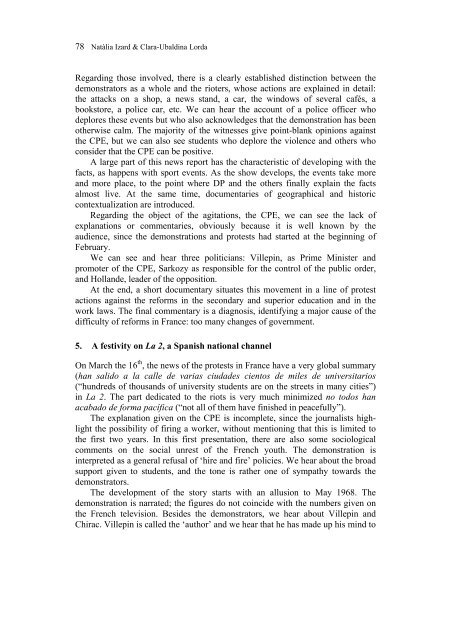Dialogue in and between Different Cultures - International ...
Dialogue in and between Different Cultures - International ...
Dialogue in and between Different Cultures - International ...
Create successful ePaper yourself
Turn your PDF publications into a flip-book with our unique Google optimized e-Paper software.
78 Natàlia Izard & Clara-Ubald<strong>in</strong>a Lorda<br />
Regard<strong>in</strong>g those <strong>in</strong>volved, there is a clearly established dist<strong>in</strong>ction <strong>between</strong> the<br />
demonstrators as a whole <strong>and</strong> the rioters, whose actions are expla<strong>in</strong>ed <strong>in</strong> detail:<br />
the attacks on a shop, a news st<strong>and</strong>, a car, the w<strong>in</strong>dows of several cafés, a<br />
bookstore, a police car, etc. We can hear the account of a police officer who<br />
deplores these events but who also acknowledges that the demonstration has been<br />
otherwise calm. The majority of the witnesses give po<strong>in</strong>t-blank op<strong>in</strong>ions aga<strong>in</strong>st<br />
the CPE, but we can also see students who deplore the violence <strong>and</strong> others who<br />
consider that the CPE can be positive.<br />
A large part of this news report has the characteristic of develop<strong>in</strong>g with the<br />
facts, as happens with sport events. As the show develops, the events take more<br />
<strong>and</strong> more place, to the po<strong>in</strong>t where DP <strong>and</strong> the others f<strong>in</strong>ally expla<strong>in</strong> the facts<br />
almost live. At the same time, documentaries of geographical <strong>and</strong> historic<br />
contextualization are <strong>in</strong>troduced.<br />
Regard<strong>in</strong>g the object of the agitations, the CPE, we can see the lack of<br />
explanations or commentaries, obviously because it is well known by the<br />
audience, s<strong>in</strong>ce the demonstrations <strong>and</strong> protests had started at the beg<strong>in</strong>n<strong>in</strong>g of<br />
February.<br />
We can see <strong>and</strong> hear three politicians: Villep<strong>in</strong>, as Prime M<strong>in</strong>ister <strong>and</strong><br />
promoter of the CPE, Sarkozy as responsible for the control of the public order,<br />
<strong>and</strong> Holl<strong>and</strong>e, leader of the opposition.<br />
At the end, a short documentary situates this movement <strong>in</strong> a l<strong>in</strong>e of protest<br />
actions aga<strong>in</strong>st the reforms <strong>in</strong> the secondary <strong>and</strong> superior education <strong>and</strong> <strong>in</strong> the<br />
work laws. The f<strong>in</strong>al commentary is a diagnosis, identify<strong>in</strong>g a major cause of the<br />
difficulty of reforms <strong>in</strong> France: too many changes of government.<br />
5. A festivity on La 2, a Spanish national channel<br />
On March the 16 th , the news of the protests <strong>in</strong> France have a very global summary<br />
(han salido a la calle de varias ciudades cientos de miles de universitarios<br />
(“hundreds of thous<strong>and</strong>s of university students are on the streets <strong>in</strong> many cities”)<br />
<strong>in</strong> La 2. The part dedicated to the riots is very much m<strong>in</strong>imized no todos han<br />
acabado de forma pacífica (“not all of them have f<strong>in</strong>ished <strong>in</strong> peacefully”).<br />
The explanation given on the CPE is <strong>in</strong>complete, s<strong>in</strong>ce the journalists highlight<br />
the possibility of fir<strong>in</strong>g a worker, without mention<strong>in</strong>g that this is limited to<br />
the first two years. In this first presentation, there are also some sociological<br />
comments on the social unrest of the French youth. The demonstration is<br />
<strong>in</strong>terpreted as a general refusal of ‘hire <strong>and</strong> fire’ policies. We hear about the broad<br />
support given to students, <strong>and</strong> the tone is rather one of sympathy towards the<br />
demonstrators.<br />
The development of the story starts with an allusion to May 1968. The<br />
demonstration is narrated; the figures do not co<strong>in</strong>cide with the numbers given on<br />
the French television. Besides the demonstrators, we hear about Villep<strong>in</strong> <strong>and</strong><br />
Chirac. Villep<strong>in</strong> is called the ‘author’ <strong>and</strong> we hear that he has made up his m<strong>in</strong>d to



